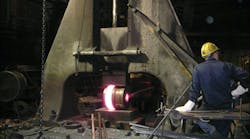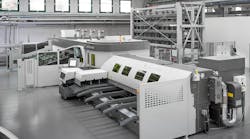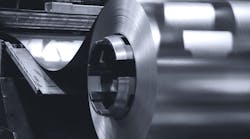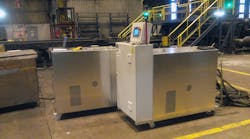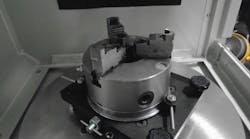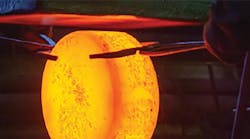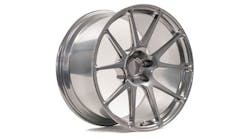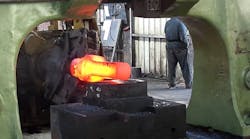If you were starting a manufacturing operation today, to produce airframe structures, for example, would you invest in a forging process? That’s the sort of question posed by analysts and finance specialists, but it often occurs to product designers or engineers seeking to realize a specific detail or quality for their concept. It’s a question that occurs even to forging industry professionals unsatisfied with some function or by-product of the process they use.
Joe Mele knew that feeling over 30 years ago, while working as director of manufacturing research with Grumman Aerospace Corp. “I noted the huge amount of machine chips that resulted from the forging of aircraft parts,” he recalled recently. “I developed an interest in attempting to reduce this amount of machining, and thus to reduce the waste of material, and to reduce the labor involved.”
Mele is the developer of the Meleform Flo-Forge process, which resulted from the interest he pursued having seen the some of the inefficiencies of open-die forging for engineered parts for aerospace programs. This forming technology manages to address Mele’s initial objectives, but it also has prospects for more current manufacturing concerns, such as production speed, process flexibility, and component accuracy. Meleform Flo-Forge is a “near-net-shape” forming technology, a concept that Mele noted no longer seems to interest forgers, possibly “because the results were not near enough,” he speculated.
Near-net-shape refers to processes that produce parts requiring little or no machining to complete. This innovative development results in stronger components and the improvement of the performance of the engine. The process normally refers to two types of forging, cold and warm.
Mele may be correct, but forgers should care about near-net-shape manufacturing for competitive reasons. After all, it is one of the chief selling points of additive manufacturing for product designers, as well as for analysts and financiers who guide business decisions. Also, near-net-shape forging represents accuracy and efficiency, which are standards for measuring improvement in any manufacturing operation.
In the 1990s, while working as a Grumman consultant and Professor of Manufacturing Technology Mele continued to pursue the matter of machine chips, and with some Grumman associates he began to lead research into alternatives. In 1993 he applied to the Defense Applied Research Projects Agency (DARPA, a unit of the U.S. Dept. of Defense) for a grant to investigate a possible solution to the "problem." Mele’s idea — that aircraft parts could be produced to near-net shape, and thereby avoid the production time and cost (and material waste) represented by machining —earned a $100,000 grant. The result of that research project is the technological development called "MELEFORM."
A final report on the project was submitted to DARPA in 1995, detailing a new technology then called "The Pullform Process” (TRD 93-019.) Mele continued to develop the technology for another 10 years, working with engineers and production managers from aluminum producers, forgers, and defense contractors to manufacture a variety of demonstration parts.
Eventually, Mele retired and attended to other matters, and the prototype machine was disassembled. But the working concept remains sound, and should be reviewed by manufacturers seeking to add or replace forming capacity.
“The design of the press for MELEFORM FLO-FORGE process is very different from the design of conventional forging presses,” according to Mele, which may partly explain some forgers’ reluctance to adopt it. “Conventional presses are very large structures weighing 6,000 to 8,000 tons and standing up to 12 stories high. They include several large hydraulic cylinders in the structure in order to attain a force of up to 50,000 tons.”
Production "scale" is an increasingly important consideration in manufacturing plant design and development, again as indicated by the recent enthusiasm generated by additive manufacturing. New forging presses can take years to develop and install, often requiring extensive foundation work and complex planning and programming to integrate the production sequence with existing operations.
Smooth Flow, Stable Results
A Meleform Flo-Forge press would weigh about four to five tons, the developer explained. It would not need a deep foundation like conventional press, just a 10x10x5-ft. (LxWxD) base for the platen. And, the machine design does not include any hydraulic cylinders so the overall assemblage is simpler.
One hydraulic cylinder is attached to the machine, to supply power for pulling and pushing a die through the press. Another significant design detail is an indexing mechanism that is part of the cylinder, which allows for the press to produce longer parts, such as airframe structures.
“The Meleform Flo-Forge production is capable of producing parts of various sizes to net shape,” according to Mele. “By eliminating machining, it provides significant savings in material, labor and time. I am confident that this new technology is simply waiting for an interested partner for continued development.”
Mele’s description of the process is somewhat suggestive of deep drawing, though the parts being formed are potentially larger and more complex. Components produced by Meleform Flo-Forge also target much more critical applications, namely parts for military and commercial aircraft programs, automotive and commercial vehicles, and structural systems.
Plate stock of various aluminum and aluminum-lithium alloys, as well as Weldalite and MMCs have been successfully processed in production trials with various manufacturers.
“The principle of the Meleform Flo-Forge technology is to shape a component part in a progressive die,” Mele noted; “the male portion of the die is segmented. The die is pulled through the Meleform Flo-Forge press. The male segments engage the tapered surface of the upper platen in the press."
“The Meleform Flo-Forge press does not apply any force,” he emphasized. “The force applied is (provided by) only one hydraulic cylinder, attached to the press with a removable pin.”
The 12-in. diameter hydraulic power cylinder is not integral to the press; it can be removed easily for maintenance or repair. The cylinder is positioned on a carriage, designed as an modular, indexing unit that makes it possible to form parts of varying lengths.
A Meleform Flo-Forge plant would use modular furnaces to maintain uniform die temperatures and move them effectively into and out of the presses. “This feature, and a uniform stable strain rate of 2.3 minutes per foot, produces stable results in the smooth material in the die,” according to the developer. “The low strain rate under pressure (about 35,000 psi) is the feature that allows material to flow in all directions to completely fill the die and to achieve net shape.”
Mele emphasized some essential points about the Meleform process, in particular that it does not remove material. Rather, the process “moves” material at a constant temperature and constant strain rate. The parts it forms have flash (ensuring exactness) and minimum (or no) folds and/or voids.
The results can be impressive. A 20-ft.-long part can be formed fabricated in one day, Mele said, while the time in the press would be only four hours.
In the test programs with various manufacturers the Meleform Flo-Forge system produced net-shape parts with RMS-32 surface finish. Other than removing the flash, no other post-processing is needed. The system was demonstrated effective at forming aircraft wing panels, spar beams, engine bulkheads; ballistic missile barrel sections; and automotive control arms.
The modularity and flexibility of the process design would be advantageous to plants of various sizes, with or without specific assets already in place. Developing Meleform Flo-Forge will not be difficult, Mele contended. A greenfield or start-up operation is an obvious possibility, too. In operation, the system would address problems for manufacturing programs concerned about long lead-times, material waste, and surface finishing.
Mele also noted the system has no EPA restrictions related to it. “The presses do not require hydraulic cylinders for pressure,” Mele pointed out. “The cross-section design is inexpensive, easy to assemble, and easy to disassemble if necessary to relocate.”
“The layout of the modular presses will require plant layout engineers,” he added. “For example, the furnaces should be designed to move on rails to facilitate quick response to the needs of the Meleform Flo-Forge system.”
Developing such a plant would find a market among buyers of critical forged parts, he predicted. The output would have applications for aerospace and defense structures, jet engines, automobiles, railroad cars, trucks and trailers, and bridge or tunnel construction, Mele suggested.
So what are the prospects for the Meleform Flo-Forge system to be adopted by investors and operators starting up a plant today? A basic issue to be overcome is resistance to change. Operators are confident of the processes they have learned. Manufacturers want to execute their familiar programs with just a few improvements, like fewer machining chips, for example.
On the other hand, product designers and buyers often seem to have a very definite notion of what they want, a product that is manufactured to address a particular problem. Neither designers, nor manufacturers, nor buyers may be alert to the change in processes that their ideas are fostering. Together their interests may be shaping some new approach to forming engineered parts. Or in this case, “net shaping.”
“It seems that ‘net shape’ is not really understood,” Mele concluded. Possibly not for much longer.
